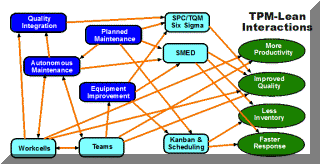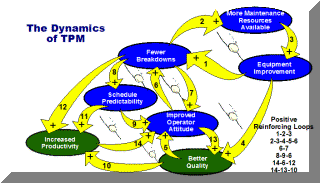The Dynamics of Total Productive Maintenance
Supplementing the Pillars of TPM
The static model of (figure 5) is a starting point for understanding TPM. But pillars on the Parthenon do not fully explain the concept or the effects. TPM is a dynamical system with reinforcing loops and interactions. The various "pillars" interact with each other and with other aspects of the larger production system. When properly designed and executed, the results are far beyond those that would be expected from summing the individual parts.
Figures 9 and 10 attempt to show these dynamic effects. While these figures improve upon the static model, they are also incomplete and, still, not totally adequate. Notice that the elements of figure 9 partly involve equipment and technology and partly involve humans and psychology. This reflects the Socio-Technical nature of the system.
Virtuous Circles In TPM
Figure 9 is a causal diagram. The arrows indicate causal connect tions between various effects. Plus or minus signs show whether the causality tends to increase or decrease the effect. The numbers identify each causality arrow for purposes of discussion. For example, arrow #2 indicates that fewer breakdowns will increase the maintenance resources that are available.
- When the condition of equipment improves, it results in fewer breakdowns.
- With fewer breakdowns, less time is required from maintenance to respond to emergencies. This makes more maintenance resources available.
- With additional resources, maintenance can work more on equipment improvement with overhauls, redesign and improved service.
- When equipment improves, quality is better.
- Better quality improves operator attitudes.
- With improved attitudes, operators take better care of the equipment and prevent more breakdowns.
- Fewer breakdowns reduce operator frustration and improve operator attitudes.
- Fewer breakdowns lead to more predictability in the schedule, e.g. fewer changes and rush jobs.
- Increased schedule predictability and stability reduces operator frustration and improves operator attitudes.
- Improved quality leads to more productivity.
- Improved schedule predictability increases productivity since less time is wasted on unnecessary changeovers, coordination and general commotion.
- Fewer breakdowns increase equipment availability and bring increased productivity.
- Improved operator attitudes bring improved quality through more attention and dedication.
- Increased productivity improves operator attitudes--everyone wants to do a good job.
Figure 9 has at least six reinforcing feedback loops. In such loops, one element increases another which in turn, increases the first. Like a snowball rolling down hill it continuously builds and, as it builds, rolls faster, and thus, grows faster. The strange little icons within this diagram represent a rolling snowball. This snowball effect is the mechanism behind most exponential growth curves.

W. Edwards Deming
All models are wrong.
Some models are useful.
Models Influence Thinking
A difficulty with models of any sort is that people tend to identify them with the real system. But, as Alfred Korzybski stated, "The map is not the territory." Models, by their nature are simplified versions of reality. They approximate certain aspects of reality and ignore others. This simplifies our perception and makes the problem comprehensible. The danger is that some of the ignored aspects are, in fact, critical to the issue we are trying to understand. Deming's quote (above) also relates to this.
The fallacies that a model introduces are often hazardous because they are subtle and unconscious. Not knowing what you do not know is a most dangerous situation as Oedipus discovered in early Greek tragedy,
System Robustness
If we take the Parthenon model of TPM too literally, it implies that the TPM system is quite robust. It implies that each pillar is independent. A crack in the column or even a missing column seems unlikely to bring down the entire structure. Thus managers are tempted to ignore or postpone aspects of TPM that they perceive as difficult, expensive or unpleasant.
Corporate culture is one such difficult and unpleasant issue. Suppose a company implements TPM without addressing their negative corporate culture. The improvement in operator attitudes in figure 9 is not realized or is negated by the overwhelmingly unpleasant culture. This cancels out three of the most important reinforcing loops and will seriously limit TPM's gains.
Benefit Growth
The Parthenon model (subtly) implies that the benefit growth is more or less linear and depends on how well each component (pillar) is implemented and when it is implemented. It would lead us to imagine that two stout columns are equivalent to five skinny columns. This may or may not be more or less true, depending on many factors in the individual situation.
The Parthenon model also implies that once a "pillar" is in place, no further construction is required; Do this, get that; a linear relationship.
The dynamic model, in contrast, emphasizes the feedback loops that often lead to exponential growth. It also shows, more clearly, relationships between various aspects. It implies the very complex and (often) unpredictable behavior of dynamic systems.
Limits of The Dynamic Model
The dynamic model of figure 9 also has limitations. It is not intended to replace the Parthenon model but, rather, to supplement it.
One difficulty with the dynamic model is that it gives few hints about the tasks or techniques required for implementation. With the Parthenon model we can ask, for example, "What do we have to do to integrate Maintenance and Quality?" The answers lead to specific tasks and tools for accomplishing those tasks.
In reality, both models are necessary and there are undoubtedly other models or variations that would also be helpful. It is like observing sunsets. A sunset looks very different from a beach, from a mountain valley, the desert, the arctic or from an aircraft. Each perspective is different and each has value.
TPM & The Larger Lean System

Figure 10 Interactions of TPM and The Larger Lean System
Arrows in this diagram indicate a positive influence. Double-headed arrows indicate a mutually reinforcing influence.
While figure 9 attempts to show the dynamics of TPM within the maintenance system, figure 10 illustrates some of the interactions between TPM elements (pillars) and elements of the larger Lean system.
Workcells, for example, are an important element of Lean. Workcells encourage people to function as a team and teams make the cells function more efficiently. Workcells also improve quality and productivity. Workcells and teams are a natural fit with Autonomous Maintenance--the teams maintain the equipment and Autonomous Maintenance gives the teams greater control which provides motivation. Workcells and Quality Integration are also a natural fit--the same people responsible for quality are also responsible for maintenance.
Many, many more such interactions exist. It is impossible to show them all and show them accurately on a computer monitor.
![]()
■ ■ ■ ■ ■ ■ ■



